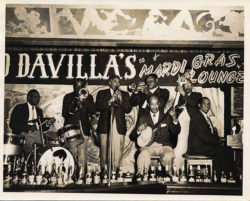Andy Anderson
Jazz trumpeter Andy Anderson had a successful career working in many jazz clubs and dance halls in New Orleans from the 1920s through the 1960s.

Courtesy of Louisiana State Museum
Paul Barbarin Band. Unidentified
Andrew Anderson, most commonly known as “Andy” Anderson, was a ragtime, early jazz, and brass band trumpeter from New Orleans. A relatively obscure figure in early jazz history, Anderson is perhaps best known for playing in Oscar “Papa” Celestin’s famed Tuxedo Band, though his roles as bandleader and composer brought him much local fame during his lifetime.
Anderson was born on August 10, 1903, in Mandeville, Louisiana. His father, George Anderson, was a bass player who played with the influential Bunk Johnson in Mandeville during the mid-1910s. It was Andrew’s brother who bought him his first cornet and taught him the basics, leading the young musician toward a lifelong career of trumpet playing. To supplement his informal training, Anderson also took a correspondence course from the American School of Music. Growing up in Mandeville, he played in a number of “spasm bands,” informal ragtime/proto-jazz performance groups that often incorporated found objects, kazoos, and other instruments into their playing.
By the time Anderson had relocated to New Orleans in his twenties, Storyville, a legal red-light district that nurtured much early jazz music, had already been closed for a number of years. He held a spot in Willie Foster’s band in the mid-1920s but soon organized and became the bandleader of the Pelican Silvertone Band. It was with them that he would later compose and perform his signature tune, “Chant of the Tuxedos.” The Pelican Silvertone Band included Anderson on trumpet and vocals; Martin Cole on tenor saxophone; Joe Robertson on piano; Leonard Mitchell on guitar, banjo, and vocals; and Charles Sylvester on drums. This era would also bring Anderson multiple gigs with jazz greats Paul Barnes and Jim Robinson, as well as musical affiliations with “Papa” Celestin and A. J. Piron—relationships that would last well into the 1940s. Anderson took lessons from Pinchback Touro as well, who in turn enlisted Anderson in a federally supported Works Progress Administration (WPA) band during the Great Depression. This work was a desperately needed relief at a time when jobs were scarce.
In 1934 Anderson became a member of Celestin’s Tuxedo Band, a position he would hold until the end of the decade. The 1950s would bring spots with Paul Barbarin and a recording session with bandleader/arranger George Lewis for the Verve label. Anderson would also record with the Young Tuxedo Brass Band on the Jazz Begins: Sounds of New Orleans Streets; Funeral and Parade Music release from Atlantic studios in 1959. As a sought-after brass band musician, Anderson performed with the Henry Allen Brass Band, the Eureka Brass Band, the Tuxedo Brass Band, and many more.
Although he recorded often in ensembles, Anderson was likely never recorded as a lead instrumentalist, and, thus, little aural information about his personal playing style survives. Like countless other musicians of his era, Anderson performed at Preservation Hall in the last decades of his life. In 1967 Anderson recorded the album Grace and Beauty with a group playing under the name New Orleans Ragtime Orchestra and which included Clem Tervalon (bass) and Cié Frazier (drums); it was led by Swedish pianist and jazz enthusiast Lars Edegran. At the time of his death, on December 19, 1982, in New Orleans, Anderson had been a working traditional musician in the city for the majority of the twentieth century.
